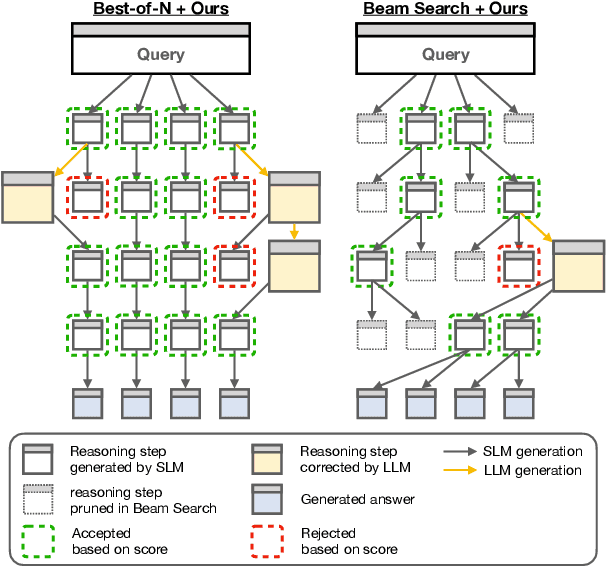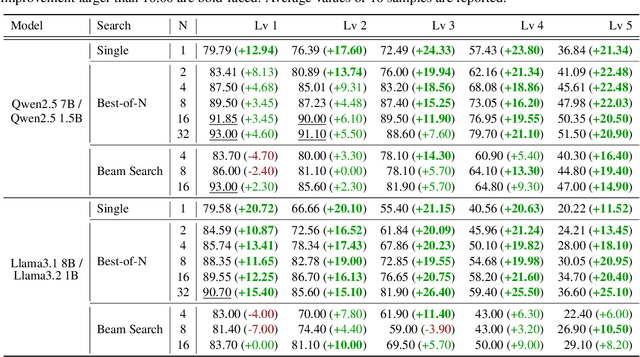Yujin Kim
MMM: Quantum-Chemical Molecular Representation Learning for Combinatorial Drug Recommendation
Oct 09, 2025Abstract:Drug recommendation is an essential task in machine learning-based clinical decision support systems. However, the risk of drug-drug interactions (DDI) between co-prescribed medications remains a significant challenge. Previous studies have used graph neural networks (GNNs) to represent drug structures. Regardless, their simplified discrete forms cannot fully capture the molecular binding affinity and reactivity. Therefore, we propose Multimodal DDI Prediction with Molecular Electron Localization Function (ELF) Maps (MMM), a novel framework that integrates three-dimensional (3D) quantum-chemical information into drug representation learning. It generates 3D electron density maps using the ELF. To capture both therapeutic relevance and interaction risks, MMM combines ELF-derived features that encode global electronic properties with a bipartite graph encoder that models local substructure interactions. This design enables learning complementary characteristics of drug molecules. We evaluate MMM in the MIMIC-III dataset (250 drugs, 442 substructures), comparing it with several baseline models. In particular, a comparison with the GNN-based SafeDrug model demonstrates statistically significant improvements in the F1-score (p = 0.0387), Jaccard (p = 0.0112), and the DDI rate (p = 0.0386). These results demonstrate the potential of ELF-based 3D representations to enhance prediction accuracy and support safer combinatorial drug prescribing in clinical practice.
Multi-channel convolutional neural quantum embedding
Sep 26, 2025Abstract:Classification using variational quantum circuits is a promising frontier in quantum machine learning. Quantum supervised learning (QSL) applied to classical data using variational quantum circuits involves embedding the data into a quantum Hilbert space and optimizing the circuit parameters to train the measurement process. In this context, the efficacy of QSL is inherently influenced by the selection of quantum embedding. In this study, we introduce a classical-quantum hybrid approach for optimizing quantum embedding beyond the limitations of the standard circuit model of quantum computation (i.e., completely positive and trace-preserving maps) for general multi-channel data. We benchmark the performance of various models in our framework using the CIFAR-10 and Tiny ImageNet datasets and provide theoretical analyses that guide model design and optimization.
Exploring Multimodal Diffusion Transformers for Enhanced Prompt-based Image Editing
Aug 11, 2025Abstract:Transformer-based diffusion models have recently superseded traditional U-Net architectures, with multimodal diffusion transformers (MM-DiT) emerging as the dominant approach in state-of-the-art models like Stable Diffusion 3 and Flux.1. Previous approaches have relied on unidirectional cross-attention mechanisms, with information flowing from text embeddings to image latents. In contrast, MMDiT introduces a unified attention mechanism that concatenates input projections from both modalities and performs a single full attention operation, allowing bidirectional information flow between text and image branches. This architectural shift presents significant challenges for existing editing techniques. In this paper, we systematically analyze MM-DiT's attention mechanism by decomposing attention matrices into four distinct blocks, revealing their inherent characteristics. Through these analyses, we propose a robust, prompt-based image editing method for MM-DiT that supports global to local edits across various MM-DiT variants, including few-step models. We believe our findings bridge the gap between existing U-Net-based methods and emerging architectures, offering deeper insights into MMDiT's behavioral patterns.
When Model Knowledge meets Diffusion Model: Diffusion-assisted Data-free Image Synthesis with Alignment of Domain and Class
Jun 18, 2025Abstract:Open-source pre-trained models hold great potential for diverse applications, but their utility declines when their training data is unavailable. Data-Free Image Synthesis (DFIS) aims to generate images that approximate the learned data distribution of a pre-trained model without accessing the original data. However, existing DFIS meth ods produce samples that deviate from the training data distribution due to the lack of prior knowl edge about natural images. To overcome this limitation, we propose DDIS, the first Diffusion-assisted Data-free Image Synthesis method that leverages a text-to-image diffusion model as a powerful image prior, improving synthetic image quality. DDIS extracts knowledge about the learned distribution from the given model and uses it to guide the diffusion model, enabling the generation of images that accurately align with the training data distribution. To achieve this, we introduce Domain Alignment Guidance (DAG) that aligns the synthetic data domain with the training data domain during the diffusion sampling process. Furthermore, we optimize a single Class Alignment Token (CAT) embedding to effectively capture class-specific attributes in the training dataset. Experiments on PACS and Ima geNet demonstrate that DDIS outperforms prior DFIS methods by generating samples that better reflect the training data distribution, achieving SOTA performance in data-free applications.
Distilling Realizable Students from Unrealizable Teachers
May 14, 2025Abstract:We study policy distillation under privileged information, where a student policy with only partial observations must learn from a teacher with full-state access. A key challenge is information asymmetry: the student cannot directly access the teacher's state space, leading to distributional shifts and policy degradation. Existing approaches either modify the teacher to produce realizable but sub-optimal demonstrations or rely on the student to explore missing information independently, both of which are inefficient. Our key insight is that the student should strategically interact with the teacher --querying only when necessary and resetting from recovery states --to stay on a recoverable path within its own observation space. We introduce two methods: (i) an imitation learning approach that adaptively determines when the student should query the teacher for corrections, and (ii) a reinforcement learning approach that selects where to initialize training for efficient exploration. We validate our methods in both simulated and real-world robotic tasks, demonstrating significant improvements over standard teacher-student baselines in training efficiency and final performance. The project website is available at : https://portal-cornell.github.io/CritiQ_ReTRy/
Guiding Reasoning in Small Language Models with LLM Assistance
Apr 14, 2025



Abstract:The limited reasoning capabilities of small language models (SLMs) cast doubt on their suitability for tasks demanding deep, multi-step logical deduction. This paper introduces a framework called Small Reasons, Large Hints (SMART), which selectively augments SLM reasoning with targeted guidance from large language models (LLMs). Inspired by the concept of cognitive scaffolding, SMART employs a score-based evaluation to identify uncertain reasoning steps and injects corrective LLM-generated reasoning only when necessary. By framing structured reasoning as an optimal policy search, our approach steers the reasoning trajectory toward correct solutions without exhaustive sampling. Our experiments on mathematical reasoning datasets demonstrate that targeted external scaffolding significantly improves performance, paving the way for collaborative use of both SLM and LLM to tackle complex reasoning tasks that are currently unsolvable by SLMs alone.
Evaluating Visual Explanations of Attention Maps for Transformer-based Medical Imaging
Mar 12, 2025Abstract:Although Vision Transformers (ViTs) have recently demonstrated superior performance in medical imaging problems, they face explainability issues similar to previous architectures such as convolutional neural networks. Recent research efforts suggest that attention maps, which are part of decision-making process of ViTs can potentially address the explainability issue by identifying regions influencing predictions, especially in models pretrained with self-supervised learning. In this work, we compare the visual explanations of attention maps to other commonly used methods for medical imaging problems. To do so, we employ four distinct medical imaging datasets that involve the identification of (1) colonic polyps, (2) breast tumors, (3) esophageal inflammation, and (4) bone fractures and hardware implants. Through large-scale experiments on the aforementioned datasets using various supervised and self-supervised pretrained ViTs, we find that although attention maps show promise under certain conditions and generally surpass GradCAM in explainability, they are outperformed by transformer-specific interpretability methods. Our findings indicate that the efficacy of attention maps as a method of interpretability is context-dependent and may be limited as they do not consistently provide the comprehensive insights required for robust medical decision-making.
Self-Training Elicits Concise Reasoning in Large Language Models
Feb 28, 2025Abstract:Chain-of-thought (CoT) reasoning has enabled large language models (LLMs) to utilize additional computation through intermediate tokens to solve complex tasks. However, we posit that typical reasoning traces contain many redundant tokens, incurring extraneous inference costs. Upon examination of the output distribution of current LLMs, we find evidence on their latent ability to reason more concisely, relative to their default behavior. To elicit this capability, we propose simple fine-tuning methods which leverage self-generated concise reasoning paths obtained by best-of-N sampling and few-shot conditioning, in task-specific settings. Our combined method achieves a 30% reduction in output tokens on average, across five model families on GSM8K and MATH, while maintaining average accuracy. By exploiting the fundamental stochasticity and in-context learning capabilities of LLMs, our self-training approach robustly elicits concise reasoning on a wide range of models, including those with extensive post-training. Code is available at https://github.com/TergelMunkhbat/concise-reasoning
Subspace-wise Hybrid RL for Articulated Object Manipulation
Dec 11, 2024Abstract:Articulated object manipulation is a challenging task, requiring constrained motion and adaptive control to handle the unknown dynamics of the manipulated objects. While reinforcement learning (RL) has been widely employed to tackle various scenarios and types of articulated objects, the complexity of these tasks, stemming from multiple intertwined objectives makes learning a control policy in the full task space highly difficult. To address this issue, we propose a Subspace-wise hybrid RL (SwRL) framework that learns policies for each divided task space, or subspace, based on independent objectives. This approach enables adaptive force modulation to accommodate the unknown dynamics of objects. Additionally, it effectively leverages the previously underlooked redundant subspace, thereby maximizing the robot's dexterity. Our method enhances both learning efficiency and task execution performance, as validated through simulations and real-world experiments. Supplementary video is available at https://youtu.be/PkNxv0P8Atk
Expressivity of deterministic quantum computation with one qubit
Nov 05, 2024Abstract:Deterministic quantum computation with one qubit (DQC1) is of significant theoretical and practical interest due to its computational advantages in certain problems, despite its subuniversality with limited quantum resources. In this work, we introduce parameterized DQC1 as a quantum machine learning model. We demonstrate that the gradient of the measurement outcome of a DQC1 circuit with respect to its gate parameters can be computed directly using the DQC1 protocol. This allows for gradient-based optimization of DQC1 circuits, positioning DQC1 as the sole quantum protocol for both training and inference. We then analyze the expressivity of the parameterized DQC1 circuits, characterizing the set of learnable functions, and show that DQC1-based machine learning (ML) is as powerful as quantum neural networks based on universal computation. Our findings highlight the potential of DQC1 as a practical and versatile platform for ML, capable of rivaling more complex quantum computing models while utilizing simpler quantum resources.
 Add to Chrome
Add to Chrome Add to Firefox
Add to Firefox Add to Edge
Add to Edge